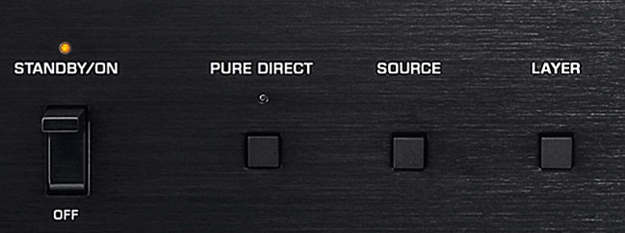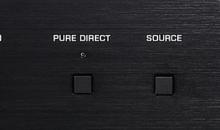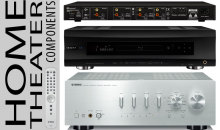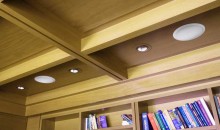Understanding DSP and Surround Sound Modes
A lot of our articles have to do with choosing the right product or setting it up properly, but sometimes you need to know how to use what you have. Using surround sound modes properly is something I don’t see a lot of people doing most of the time. In fact, most of the time I see people using whatever surround mode happens to be engaged on the receiver. Occasionally, they wonder why everything sounds weird, or they click the button until they get a lot of program material in the surrounds. Let’s lay down some basic foundations.
Purity Sounds Better Than it Actually Is
There are two surround sound modes I think everyone should be very familiar with. There are variations, but in general, most AV receivers have these.
The first is Direct/Straight, or Pure Direct mode. Pure Direct mode is “garbage in, garbage out” and is meant primarily for listening without any alteration from the receiver. Pure Direct mode will feed your source directly to the amplifiers and bypass your bass management settings and room correction. Often, Pure Direct will also turn off your video circuitry. It is meant to use the amps in your receiver and not much else. There is an “audiophile” thought that any process going on in your receiver that isn’t directly contributing to the sound is somehow detrimental. That means that any video processing or passthrough will damage the sound quality. Of course, this makes no sense but don’t tell that to the audiophile. When Pure Direct is handy is when you’ve made some changes to your system and you’re not sure if you like what you hear. Engage Pure Direct and hear what it sounds like without the changes.
Direct or Straight (there are a ton of names for it) matches the input to the decoding. With many modern receivers, you can “force” a specific upmixing. So, no matter what signal comes in, it will use the Dolby Surround upmixer to utilize as many speakers as possible. Direct or Straight mode will take an incoming stereo signal and only use the Left and Right speakers. Since you may have a subwoofer in your system, Direct or Stereo still use the sub, provided your main speakers are set to Small (as you should regardless of the physical size of the speakers). Most of the time, Straight or Direct modes will default to the native audio formats when you give the receiver a Dolby (Digital, TrueHD, etc), DSD, MLP or DTS multichannel source. Receivers are pretty smart and so they figure you’re not going to be as interested in bypassing much when you have a nice multichannel signal. Most importantly, the Direct or Straight mode still utilizes the room correction system in your receiver. You paid extra for it, you should use it!
Fancier DSP Modes for the More Experimental Among Us
I’m not a DSP-hater. I think they can be pretty cool, particularly when you aren’t using really expensive speakers. Taking your stereo CDs and aging them back through Dolby Pro Logic II or IIx, for example, can give them new life. Some of those Sci-Fi or Movie modes can also bring alive some of the movies you’re watching on cable or satellite TV stations that aren’t encoded in surround sound. There’s nothing wrong with experimenting with the modes afforded you by the manufacturer of your AV receiver, I just don’t want you to be ignorant or unaware of what mode you’re using. Also, the Dolby Surround and DTX:X upmixers let you take your surround signals and mix some of them into the overhead speakers. Experiment with them. You may like what you hear!
Party On, Wayne!
One of the most practical and fun DSP modes that exists in nearly every AV receiver is the 7-channel Stereo or All-Channel Stereo mode that sends a stereo signal to every pair of amps in your receiver (and often a summed mono signal to your center channel as well). The result is a lot of sound in your theater. Some Party modes will also engage the additional Zones you may be using. On either case, this mode is a boon for creating tons of sound-particularly in a larger room. It’s also handy for when you simply can’t turn up a single pair of speakers loud enough-perhaps because of the available system power or due to the limitations of the point at which a single pair of speakers may distort.
German Bathroom May Be Neat, But do You Need It?
That leaves all the rest of the DSP surround modes. While Jazz Club and Cathedral might be novel for particular music pieces, they really don’t have any place in your regular home theater use. In 99.9% of cases (based on our own user-inquiries) these modes get listened to once (at most), never to be used again. Fortunately, most AV receiver manufacturers (with the notable exception of one or two holdouts) have opted to limit the amount of DSP modes available on newer products. I say fortunately, because the more you eliminate the oddball DSP modes, the less likely it is that you’ll stole into your friend’s house to watch a movie in the latest Spectacle or Stadium mode that he just loves due to the enhanced surround effects.
In summary, remember this: Friends don’t let friends use bad DSP.










Good article on introduction to DSP modes and what they do to the sound input!
I appreciate our music system now, the sound is tremendous and really plays well after I read this article- great info. Thanks!
What exactly is Surr Decoder on my Yamaha 679 Av reciver?
What do you think of Yamaha Cinema DSP. ? Adventure sci-fi. Etc? Iv Been using not straight but surround standard on my Z9. Thank you
I have a 7.2.4 Dolby atmos setup and my rear back surrounds will not play when I stream a Dolby atmos program or movie through vudu or Netflix. If I switch to neural X it will play the rear back surrounds. When I play the same movie through blu-Ray every thing is fine.
That’s because Netflix and Vudu are only 5.1 atmos, not 7.1.
Agree with Mark’s comment. Now if we can just get a guide that would tell us how best to set our receivers to optimally experience these formats.
i bought a yamaha tsr-700. claims to do dolby true hd and dts master audio but not sure. The display does not say so. When i play movie with dts master audio 7.1 the back surrounds do not produce sound. extremely irritating. i need to use dts-neo 6 which is not using pure 7.1 channels. seems yamaha jipped on processing or is using ‘straight’ or ‘pure direct’ the way to get the dts-master audio (back speakers work). if not im returning this piece of crap for onkyo….thanks
There is a lot of troubleshooting you can do but the receiver should have no problems decoding TrueHD and DTS MA. First things first – go into your receiver’s audio setting and run the test tones out of every speaker. Are the tones coming out of the surround backs? If not, you’ve got either a physical connection problem, or a setting problem. First, check that the speaker wire is connected to the correct outputs on the back of the receiver (surround back and not zone 2). If everything thing looks okay, there are a few things to check. 1) Make sure you are connected via HDMI. 2) Make sure you selected the right speaker configuration when you ran your setup. 3) Check your sources and make sure they are set to output bitstream and not PCM. Hope this helps!
I run a Yamaha AVR that still provides Dolby Prologic II Music, DTS Neo 6 Music, THX Neural X Music modes among all the others.
I after years of being a near audiophile luddite that only listened to stereo music in DIRECT MODE, one day woke up and tried out these above surround listening modes. NONE of the are fancy jazz club or rock arena DSP stuff. They are powerful but in only trying to extract the surround sound ques from stereo recordings. Applying appropriate time delays while they each in their own way extract the out of phase sound for the surround speakers and sum the sound for a center channel mix. Dolby Prologic II Music offers the listener most adjustability, DTS Neo 6 Music less so and THX Neural X Music the least (as in none). I find Dolby Prologic II Music to be the best for my listening tastes and room/speaker set up. But the other two are cool too.
There is no fancy DSP manipulations with these to create some artificial Hall, Arena or such, but just simple “Hafler effect type” phase and delay. I have had the privilege of attending numerous live music events in my life, from clubs to arenas to stadiums to outdoor concert bowls. NO RECORDED MUSIC CAN TRULY REPLICATE A LIVE EVENT! But good hifi and good source recordings can help create an illusion of audio enjoyment. Finally after years of being a stick in the mud DIRECT ONLY stereo listening, setting up especially Dolby Prologic II Music for hi-fi listening has brought me closer to home audio beginning to sound more like live events than any specific gear, other tweaks, audiophile stuff.
You get a good feeling of the sound of the recording studio, room, hall or if a live concert event recording the sound of the arena, concert hall or stadium used with especially IMO best with Dolby Prologic II Music.
The newer UP MIXERS for music in Atmos or DTS X probably achieve similar or better results, but I don’t run Atmos or DTS -X in my A/V Room.
What about just using the auto DSP? I seem to get great sound from my Yamaha 7.2 when I do. Any drawbacks to this?
With most receivers, “auto” refers to matching the input. So, if your receiver sees a Dolby Digital input, it’ll use the Dolby Surround upmixer. If it sees a DTS signal, it’ll use the DTS upmixer. Either way, it will try to utilize as many speakers as possible. Usually. Check your receiver’s manual for verification (or just walk around your room and put your ear next to all your speakers). This is a long-winded way of saying, “Yes, the auto setting is just fine.”
I agree with a previous comment no gear will replicate a live event. Room and space acoustics definitely become part of the make up of that performance. The audiophile rabbit is deep. What is audiophile? Does your room need to be built like a studio such Abbey Road Studios? Is purity of presentation based on the performer’s presentation or is it the music writer’s original intention the original focus of the intention of a song? Tricky slope to slide down. Me enjoy your gear enjoy the music and relax